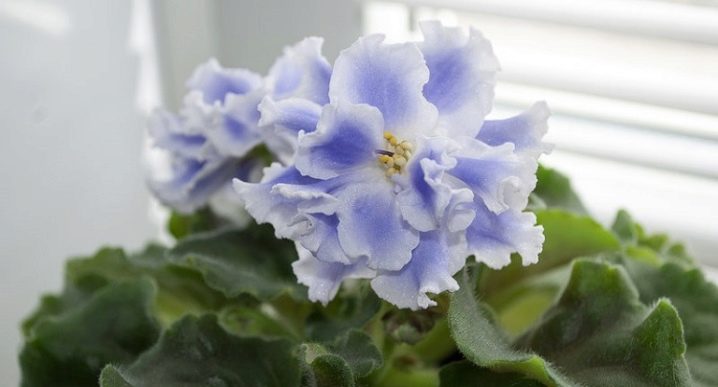Plant care at home
SM-Zephyr is a bit of a demanding variety, the color of which is highly dependent on temperature and light, which makes it a little capricious. And the rest of the variety is very resistant to external, unfavorable factors.
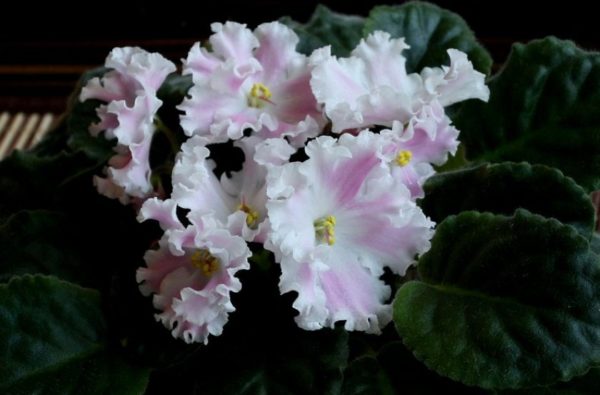
Violet needs proper care.
Place of cultivation
The flower forms a rosette well in abundant light, but flowers usually brighten under such conditions. It is imperative, as with all Saintpaulias, to be protected from direct sunlight, because they burn the delicate leaves.
The temperature of no less light affects the color of the petals:
- If you create cooler conditions (it is vital to maintain the temperature not lower than + 16 °), there is a strong lightening of the colors, which sometimes brings the color to white, with barely noticeable pink prints, more like spraying;
- An increase in temperature (about 26 ° -28 °, but not higher) darkens the color, to a pure pink, sometimes even raspberry.
The optimal temperature regime is considered to be the interval from 22 to 24 °.
An increase and decrease in the level of moisture in the air also has a detrimental effect on flowers:
- Humidity above 70% leads to decay of leaves and growth points;
- A decrease below 40% - dries out the substrate and sheets.
Attention! Both options lead to the death of the flower, if measures are not taken in time.
Watering and feeding
Like all Saintpaulias, CM-Zephyr can be watered in two ways:
- Classic (in a pan or under the leaves) - about once every 7 days, water is poured into the pan (under the leaves), and 20 minutes after the procedure, the excess is drained. Mineral dressing is applied periodically, alternating watering - once with fertilizer, the next with clean water, and the dosage is halved;
-
Wick - a string is placed in a pot and taken out with a drainage hole, a container with water is placed under a flowerpot. The water is constantly in the container, and the fertilizers are there constantly, and its concentration decreases 7-8 times, according to the instructions.
Transplant and pruning
It is important to choose the soil before transplanting. You can just buy a ready-made mixture for Saintpaulias at a flower shop.
When making a homemade mixture, you need to consider what type of watering is used. For the classic, the composition includes:
- 1 part of sheet soil;
- 1 part perlite;
- 1 part peat;
- 0.5 parts sphagnum moss.
For the wick type, only two ingredients are needed in equal proportions:
- Peat;
- And perlite.
 Prune the bush as needed, removing the dying ones:
Prune the bush as needed, removing the dying ones:
- Sheets;
- Peduncles;
- And during the transplant, the roots.
In addition to hygienic pruning, it is important to obtain material for vegetative propagation:
- Healthy leaves 2-3 rows;
- Blooming flower stalks;
- Stepsons.
A transplant is a necessity for the healthy growth of a flower, it is carried out:
- To increase the size of the flowerpot - as the young bush grows, it needs more and more space;
- Replacing unusable soil - the substrate is gradually depleted, and requires regular replacement, which is carried out 1-2 times a year;
- In case of illness, the transplant is carried out as in the previous case, but the flowerpot and the plant are additionally processed, sometimes the size of the pot has to be reduced.
Reproduction
This variety reproduces well by any convenient method:
-
Leaf cuttings - leaves of the second and third row are rooted in soil, water or moss. Sheets give consistently several children;
- By stepchildren - grown up stepchildren are separated and planted (provided they have their own roots), or rooted like a leaf cutting;
- Peduncles - not completely wilted peduncles are rooted in the ground under the film.
Description of the variety
Saintpaulia "Frosty Cherry" is a neat compact plant with simple pointed leaves with a heart-shaped base and large double flowers.Flowers of this variety can be up to 4 centimeters in diameter. In young plants, flowers are smaller in comparison with adult saintpaulias.
The color of the petals is two-tone, combining a pale pink or cherry-red core and a white edging. As they grow older, both flowers and leaves of a violet of this variety begin to become darker, acquiring a more saturated color. The fact that the life cycle of flowers is coming to an end is evidenced by their darkening and wilting.
The variety "Frosty Cherry" is very popular with flower growers due to its unpretentiousness, as well as abundant and long flowering. The blossoming flowers stay on the plants in a heap and for a very long time.
A group of peduncles near the "Frosty Cherry" is formed in the center of the rosette. The buds are formed in large numbers, gathering in dense clusters.
The flowering phase usually occurs during the summer and winter periods. The color saturation of flowers depends on a number of factors, but primarily on lighting. The better this violet is illuminated during flowering, the brighter and more intense the color of its flowers will be.
Among other advantages of violets of this variety, flower growers note the simplicity of care, resistance to temperature extremes, and the massive formation of buds during the flowering period. Despite the fact that "Frosty Cherry" is considered to be a relatively young variety, it has perfectly established itself as a prolific, undemanding and non-capricious plant, which can be grown even by inexperienced plant growers.
Distinctive features of care
To achieve rapid growth and abundant flowering is possible only if the basic rules of agricultural technology are observed.
Note! Violet blue fog is not demanding in terms of care, it is not for nothing that inexperienced growers choose it.
Temperature
For Blue Fog, a temperature range of 23-25 degrees must be observed. If the temperature drops to 18 degrees and below, the flower may die. Drafts are unacceptable for violets.
Lighting
For violets, bright but diffused light is preferred. Place flower pots on windowsills with windows facing west or east. It is possible to extend the flowering period in winter only if the daylight hours are extended with the help of fluorescent lamps.
Watering
Proper hydration is the key to successful flower cultivation. For irrigation, use settled warm water. Cold and hard water will cause the development of fungal diseases. Watering through the pan, and then drain the excess liquid. Top moisture is used to moisturize violets. Only then will you have to make sure that water does not get on the leaves and the center of the outlet.
The leaves of the violets are covered with small villi, so that when water gets on them, they quickly rot.
Top dressing
Violet Blue Mist responds positively to fertilization. For a lush and long flowering, it is necessary to choose a composition containing the following elements:
- nitrogen (N) - promotes active growth, gives the leaves a rich color;
- phosphorus (P) - activates the growth of the root system, promotes the laying of buds;
- potassium (K) - activates flowering, increases resistance to pathogens.
In small doses, add the following components:
- sulfur, magnesium - activate the growth and formation of chlorophyll;
- calcium - strengthens the tissue of the flower, making the peduncles more durable;
- iron, manganese, silicon, boron, cobalt, zinc, copper.
Apply top dressing no more than 2 times a week. Do this through a pallet or simply water from above.
Make sure that no water gets on the leaves. If you fertilize a young plant, then there should be a lot of nitrogen in the fertilizing. It is this element that contributes to the growth of green mass.
You can get a strong and beautiful flowering if you add phosphorus and potassium. It is best to feed the plant after watering. Then the active ingredients are well absorbed and absorbed by the flower.
When and how it blooms
With proper care, violets bloom almost all year round.The Blue Mist variety is also characterized by long and abundant flowering.
Types of flowers
Blue Mist buds and flowers can range in color from light blue to deep blue.
Note! The change in shade depends on the air temperature in the room where the plant is kept: the warmer, the darker the petals become
Flower shapes
The flowers of this variety consist of many double petals arranged in tiers and often forming luxurious balls. The edges of the petals are strongly corrugated, which is why the core is almost invisible.
Flowering period
The blooming period of the Blue Mist can be up to 10 months a year. Withered inflorescences give way to new ones, and a lush hat of flowers and buds constantly keeps above the rosette.
Changes in care during flowering
During the flowering period, the plant needs regular feeding to compensate for the nutrient consumption. It is not recommended to change the lighting and watering mode.
Diseases and pests
Indoor violets can suffer from the influence of diseases and parasites. The most common enemies of the violet are:
- Spider mite. This is a dangerous and rapidly spreading insect that loves to feast on the sap of the plant. You can determine the lesion by having a white sticky bloom, which is concentrated on the surface of the foliage. To eliminate parasites, it is necessary to use drugs such as Fitoverm, Actellik.
- Whitefly. This is another dangerous parasite. It occurs at low air humidity and high temperatures. To combat the whitefly, general-purpose insecticides are used.
- Mealybug. It is a sucking parasite that loves to feast on violet juice. If the plant is infected, then growth stops, and then it dies. To fight insects, you must use a solution of laundry soap.
- Powdery mildew. This is a fungal disease, which can be recognized by the characteristic whitish bloom, as in the photo on the right, which damages the leaves. A fungicide is used to combat.
- Fusarium. This is a dangerous disease that affects the roots and leaf blades first. If an affected bush was noticed, then remove it, and treat the soil with a solution of copper sulfate.
Growing conditions
The flowering of violets depends on the conditions created, we will consider them in more detail.
Priming
First of all, you need to purchase a special soil for growing Saintpaulias.
It is a light and friable nutritional mixture that contains the elements you need for your flowers.
Some growers advise adding ordinary garden soil to the soil, which is disinfected in the oven by calcining.
This is done so that the earth retains moisture better.
It is imperative that drainage is laid out on the bottom of the pot, otherwise excess moisture will linger.
Which pot should you plant?
The choice of a pot for planting violets is also an important point in breeding it.
It is believed that violets do not like large pots. The root system of these flowers takes too long to grow, and the plant does not have the energy and time for its main purpose - flowering.
A pot that is too small will not suit a violet either. Therefore, choosing the size is not easy, but there are recommendations from experienced gardeners - florists: the pot should be about 10 cm high and 10 to 13 cm in diameter.
Lighting features
Features of violets lighting: a lot of light, but at the same time exclude direct sunlight.
Attention! Violets are not friendly with the sun's rays! Moreover, the sun can cause burns and diseases on the leaves of the flower. You need to choose such a place for your pets, what would you choose for a child on the beach: light, warm, a lot of sun, but no direct rays
It is best to place your Saintpaulia pots on the windowsills on the north side of your home. If this is not possible, and your windows are located only on the south side, you can hang a thick fabric curtain on the window.It will protect the flowers from direct rays, but at the same time allow enough light to pass through.
Temperature
16-20 degrees is the required temperature for reproduction and cultivation of both our “Southern Night” variety and all other violets.
Day and night temperatures should not be the same, and they will differ by 3-4 degrees.
In winter, it is advisable to remove the flower pots from the windowsills to another place in order to avoid hypothermia of the plants.
Air humidity
All varieties of violets are known for their demanding air humidity. However, the plant cannot be sprayed.
To increase the humidity of the air, containers with water can be placed next to the flower pots. Warm showers can be held once a month for violets.
After washing the plant, dip the leaves with a paper towel so that no water drops remain. This procedure is used to improve the decorative qualities.
Pollination
In nature, pollen is carried from plant to plant by insects or wind. When growing hybrid violets, the florist has to pollinate the plants himself so that pollen does not fall on one flower from another and varietal characteristics are not lost. Another option is deliberate crossing of different varieties in order to obtain a new plant of an unusual kind.
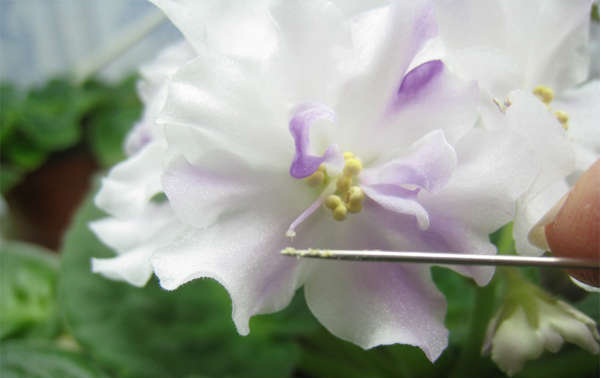
Pollination of violets
Pollination techniques
There are 3 main pollination techniques:
- the insect technique, in which pollen is transferred with a needle, soft brush, cotton swab, or clean finger;
- wind technique, when pollen is collected on a sheet of paper and gently blown onto the stamens of the mother flower;
- the technique of animals, in which the flowers of one plant touch the flowers of another, as happens when an animal passes through the thickets of grass.
All of these options, which are used to pollinate violets at home, are equally effective.
Pollen application method
Pollen from the surface of the stamens of the violet-papa is transferred to the moistened surface of the pistil.
Important! The procedure is carried out with several flowers, to increase the chances of success, it is repeated 2-3 times with a difference of a couple of days
Pollination tools
It is most convenient to use when pollinating with a disposable cotton swab. In this case, you should not mix pollen from different "dads" in order to avoid unpredictable results. After completing the procedure, the sticks are discarded.
Photo of blue flowers
Saintpaulia Blue ChiffonBlue Dragon is a legendary variety of the Sorano selection. Present in almost all collections. Violet growers love it for its large, beautifully shaped light blue flowers with a wide reddish-purple corrugated border and a white-green edge. This variety is never forgotten! He is somewhat capricious in cultivation, does not forgive the errors of agricultural technology, he loves natural light and feeding. Faded Denim (Sorano). Violet color of light blue denim. Huge semi-double and double pastel blue (color overlay as if in several layers) grooved and wavy stars are beautiful. There will be no particular problems in care if the Faded Denim lighting is getting bright enough. In dim light, the peduncles stretch out and lie down under the weight of huge flowers. Mas Toxic Spill (Robinson). Spilled poison. The moire color of the petals really looks like the multi-colored stains that come from gasoline in puddles after rain. Semi-double blue stars with polka dots and touches of white, pink and dark blue fantasy. It blooms willingly, long and abundantly. Opera's Romeo (Burdick). Romeo. Large semi-double bright blue stars. White edge and polka dots on the petals. Abundant flowering. It looks much more beautiful in life than in the photo. Optimara Annabelle (Holtkamp). Annabelle from the Optimar series. If you love field bells, then this variety is yours! This is a huge bouquet of bright blue-blue bells. Small dark foliage, compact outlet. The peculiarity of this bell-shaped variety is a slightly elongated stem. The variety is very original. RhapsodieClementine (Holtkamp).The RhapsodieHoltkamp series is distinguished primarily by its abundant bouquet bloom. Clementine's simple light blue wavy stars are gathered in a dense cap and look like a bouquet of spring snowdrops. The dark green foliage forms an even show rosette. The variety is very photogenic and often takes prizes at photo exhibitions. Vince's Choice (Eyerdom). Vince Choise blooms in large double bright blue stars with a clear white edge. Violet neat, medium-sized rosette, strong peduncles. Easy to care for. Mother's rosette-winner of the Competition "The best violet of the selection of Freddete and Eyerdom" at the Flower Vernissage 2010. (1st place). Domestic varieties are also richly presented in blue tones. Blue Mist (Morev).Well, who does not know the Blue Mist of Konstantin Morev! Very large, double sky-blue stars with lighter, wavy edges and greenish tips of the petals. Super-abundant flowering provides the variety with the love of flower growers and success at exhibitions. It grows well both on the window and under artificial lighting on the rack. Moonlight (Morev).Kostya Moreva's seedling is amazingly beautiful. Large double and airy flowers. Wavy edge of the petals. Nice neat rosette. The blue-white color combination varies according to the growing temperature. The higher the temperature, the bluer the color turns out. Heavenly Lace (Arkhipov).A very unusual variety. Dark blue semi-double and double flowers with green fringes do not fully open, leaving a contrasting light silver-green box in the center of the flower. The variety was awarded at the AVSA exhibition. I received the coveted cutting from a breeder several years ago and I still never tire of wondering and admiring the amazing color of the stars. EC-Blue Blood, EC-Blue Lagoon, EK-Heavenly Azure - blue violets by E. Korshunova. All three varieties are distinguished by very large, beautifully shaped flowers, abundant bouquets and ease of growing and care. I'm not going to part with any of these varieties and I don't want to replace them with new products. |
Violet CM-Zephyr (Seedling Moreva)
SM-Zephyr is one of the representatives of indoor Uzambore violets, which belong to the genus of hybrid Saintpaulias from the Gesneriev family. The seedling was bred and registered by Kostantin Morev, in the revision of which there are few varieties, but they are all very beautiful. The breeder himself is very scrupulous about the concept of a variety, and therefore many of his offspring are named with a note of a seedling.
Standard type and size rosette, which has rounded leaves, on elongated cuttings. The medium green color of the leaves, which depends on light and temperature, may darken slightly or approach a light shade.
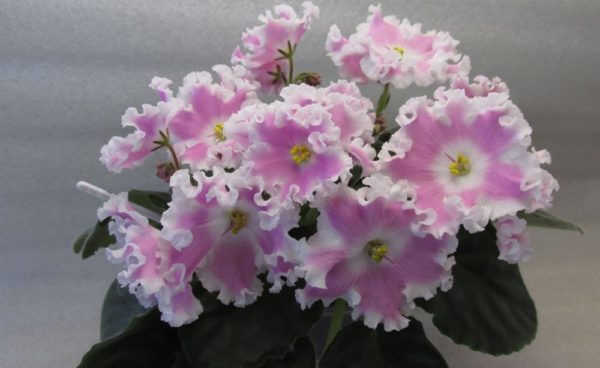
Delicate violet Marshmallow.
Important! The shape of the sheets is very recognizable, they are quilted and have a kind of ruffle along the edge. This is a feature of this variety .. The flower has the shape of a cup-shaped star, most of them are simple flowers, but sometimes semi-double specimens also happen.
The color of the flowers is quite delicate, delicate and alluring, and besides, it is often incomprehensible. In the original, the main shade is white, and in the center of the petals there are pink prints in the form of strokes. But sensitivity to temperature and light conditions changes color from white with a slight pink tint to pure bright pink
The flower has the shape of a cup-shaped star, most of them are simple flowers, but sometimes semi-double specimens also occur. The color of the flowers is quite delicate, delicate and alluring, and besides, it is often incomprehensible. In the original, the main shade is white, and in the center of the petals there are pink prints in the form of strokes. But sensitivity to temperature and light conditions changes color from white with a slight pink tint to pure bright pink.
CM-Zephyr has a sport that has curly leaves. There are various sports: photos and descriptions of which you can see on the Internet.
Features of flowering, growth and reproduction
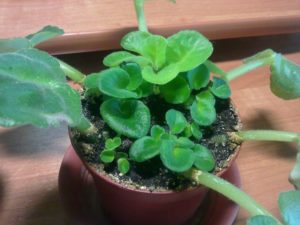 Violet babies:
Violet babies:
- Growing fast;
- And they are perfectly formed under normal conditions.
Usually, it takes no more than a year to get an adult, and the first flowering occurs earlier.
The first bloom rarely matches the description, the flowers are usually small, often not double, and may differ in color from the original.
From the second flowering onwards, the flowers take on the appropriate appearance. The flowers are large, double, and the flowering is usually nodding. Peduncles:
- Strong;
- Are short;
- Heavy flowers support well.
Depending on the temperature, the color of the flowers can change quite a lot. In the heat, flowers can be:
- Completely dark;
- Or have small white edges.
In cool conditions, the amount of white can greatly increase, sometimes crimson spots become very small and rare, or disappear altogether.
Important! Flowers do not last very long, up to a week. But the number of buds laid provides long-term flowering .. Saintpaulia can be propagated by leaf cuttings
Saintpaulia can be propagated by leaf cuttings.
All available methods are suitable for reproduction. The absence of variegation on the sheets removes the restriction on reproduction by peduncles. The non-chimeric color of the flowers allows it to be propagated by sheets. And for pasinking, only their poor formation in a given variety can serve as a limitation.
Growing from seeds
Viola seeds
The seed breeding method for pansies is quite simple. First you need to choose a sowing time.
It depends on when you want to see the first flowers:
- In order for the plant to bloom next year, it must be sown in the fall in open ground. This should be done in August or September. Viola will have time to ascend, her root system will begin to form. By the onset of frost, it will represent a fully formed bush. Having overwintered, she will present you with flowering in April, which will continue until autumn.
- If you plant pansies in the spring, they will bloom already in the year of planting. Here it is necessary to use the seedling method. We will consider it below. Such a planting is carried out at the end of winter.
- If you sow seeds in May or June directly into the ground, then the viola will begin to bloom in September. Winter will find it blooming, but next year it will bloom again.
Step-by-step instructions for growing seedlings:
The first shoots of seedlings
Before sowing, it is recommended to treat the seeds with a solution that stimulates growth, for example, you can use citron. If the seeds were purchased from an unreliable seller, they must be disinfected with a weak solution of potassium permanganate.
Pansy seeds can be stored for no more than two years, then they lose their germination.
You can make the mixture yourself. For this, garden soil, peat and rotted compost are mixed. The proportion should be 2: 2: 1.
Be sure to spill a self-prepared soil mixture with a hot solution of potassium permanganate. This will kill fungal spores that may be waiting in the wings in garden soil.
The first way: spread out the planting material on moist soil. Cover with foil and keep until sprouts appear in a dark place at a temperature of 22 degrees. Every day you need to remove the film for 10 minutes for airing.
Method two: Seeds are sown in grooves. The depth, which should be, is about 0.5 cm.The distance between them must be observed 1-2 cm.
The step between the seeds should also be 1 - 2 cm. After the grooves are sealed, water the viola. Cover with foil and put in a warm place.
Such sowing does not require keeping in the dark. The film also needs to be removed every day, for 10 - 15 minutes. Depending on the variety and quality of the planting material, the first shoots will appear in 2 - 4 weeks.
Viola seedlings
- After the emergence of seedlings, the container with seedlings must be placed in a well-lit place. Viola is not afraid of the spring sun, so the sill of the south window will suit her.
- The film from the seedling container cannot be removed immediately. It is necessary to accustom the seedlings gradually. To do this, you need to increase the airing time during the week.
- Pansies can feel quite comfortable at a temperature of + 5 + 10 degrees. Therefore, during the day, seedlings can be taken out to the balcony, terrace or yard. Fresh air will contribute to its rapid strengthening and growth.
- Viola needs to be regularly watered. It is produced when the top layer of the soil dries up. In this case, do not overfill, excess moisture will lead to rotting of the plant.
- A pick is made after 2-3 full-fledged leaves grow. The transfer is carried out in separate cups. Viola takes root well, so if the root is damaged, it's not scary. The health of the plant will not deteriorate from this, only growth may slow down a little.
- If the stalk of the dived pansies is extended. It can be deepened into the ground almost to the leaves. This will improve the appearance of the plant, make the root system stronger. New roots will grow on the surface of the deepened stem.
- After the formation of several pairs of leaves, you need to pinch the top of the stem. This will make the bush lush.
- Landing in open ground is carried out after the establishment of stable weather, without frost. The distance between the bushes should be at least 10 cm.
Pansies tend to self-pollinate
Therefore, you should not be surprised to see flowers of an unexpected color in your flower bed. By the way, it can be propagated by collecting seeds.
Sowing seeds in open ground:
- Make shallow grooves. The gap between them should be 10 cm.
- Spread the seeds, keeping a distance of about 1 - 2 cm.
- Water the crops and cover with foil.
- After emergence, the film is removed. Seedlings need to create partial shade conditions. For this, a canopy is being built. Or branches of trees with foliage are installed along the perimeter of the garden.
- Transplantation to a permanent place is carried out after the appearance of 3 leaves.
In order for the bushes to bloom profusely next year, it is not necessary to allow flowering in the first year. To do this, all the buds are cut off.
Badan: description, types and varieties, planting and care in the open field, medicinal properties and contraindications (60+ Photos & Videos) + Reviews
Peculiarities
In the room, in the gardens, and in the park beds, saintpaulias bring joy to people. They confidently compete in beauty with the most brilliant flowers of other species. But this culture still requires some effort and constant attention. To simplify the work, you can choose a relatively unpretentious violet "Blue Mist".
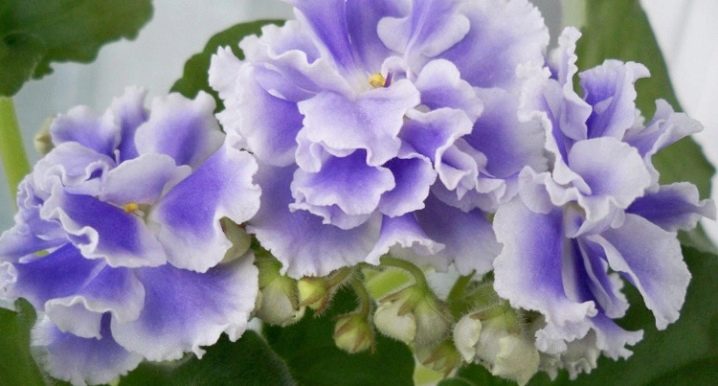
The characteristic features of the plant are:
- long flowering;
- an abundance of formed flowers;
- reproduction rate;
- outer beauty;
- increased durability of peduncles.
"Blue Fog" was created by the famous Russian breeder Konstantin Morev. This plant entered official circulation in 2001. The leaves of the culture outwardly resemble velvet. Their shape can vary greatly, it happens:
- with a heart-shaped base;
- in the form of an egg;
- oval;
- spheres.


The color of the leaves outside can be light green and dark green, and even occupy almost the entire range. From the inside, they are light green, sometimes lilac, the veins are well pronounced. The name of the variety was given by light blue and light blue flowers of the double type. The white edges of the petals look impressive. Spherical inflorescences resemble a clear cloudless sky in color.
As already mentioned, peduncles are distinguished by their strength. Flowers - 3 or 4 buds per peduncle, raised above the leaves. During the summer flowering, Saintpaulia (do not forget that this is the botanical name for violets) changes the color of its flowers. Their blues become richer. Often the white stripe along the edge disappears, by the beginning of winter, however, the usual appearance is restored.
